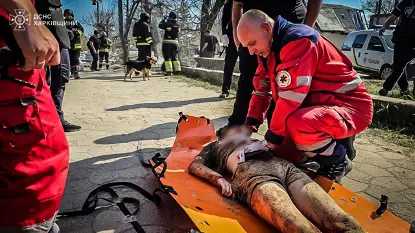Russia’s latest wave of missile attacks against Ukrainian energy infrastructure scored a victory on Thursday, with the Kremlin’s hard-to-intercept “hypersonic” and ballistic missiles punching through mostly untouched through thinning Ukrainian air defenses to hit and damage power plants across the country.
Moscow strike planners during the early hours of April 11 deployed Tu-95 strategic bombers, MiG-31K strike fighters, S-300 surface-to-surface missile systems and dozens of Iran-manufactured Shahed kamikaze drones to attack Ukraine’s north, east and south with waves of flying munitions, some carrying warheads with a half-ton of explosives.
JOIN US ON TELEGRAM
Follow our coverage of the war on the @Kyivpost_official.
According to official Ukrainian military statements, the break-down of strike weapons hurled by the Kremlin into Ukrainian air space numbered slightly more than 80: 24 aircraft-dropped X-series cruise missiles, six strike fighter-dropped Kinzhal “hypersonic” missiles, 12 anti-aircraft S-300 ballistic missiles repurposed for ground attacks, and 40 Teheran-designed flying wing attack drones.
As in past attacks, the strikes appeared to be built on a main effort of cruise missiles carried by the Tu-95 turboprops – the famous “Bear” bomber of the Cold War era – and launched from air space over Russia’s Saratov Oblast.
Parallel attacks by drones and other missiles seemed timed to hit targets simultaneously with the bomber-launched cruise missiles. Ukrainian air defense chat groups reported between seven and 11 Russian Bears were in the air. The Kremlin has used mixed-weapon tactics calculated to over-stress Ukraine’s air defense network since early 2024.

Gas Infrastructure Damaged as Russia Launches Missile Barrage on Western Ukraine
Kremlin missile or drone detonations were reported at twelve locations across a 900-kilometer (560-mile) swath of Ukraine, from the northeastern city of Kharkiv, less than 40 kilometers from the Russian border to the Lviv region, a few dozen kilometers from the Ukraine-Poland line.
Of the 84 Russian weapons fired into Ukraine, according to Ukrainian army official counts, air defenders claimed they shot down or forced out of planned trajectory almost exactly two-thirds of the ingressors, including 20 out of 24 of the cruise missiles (each toting a warhead in the 400-500-kilogram range), and 39 out of 40 of the smaller Iranian drones.
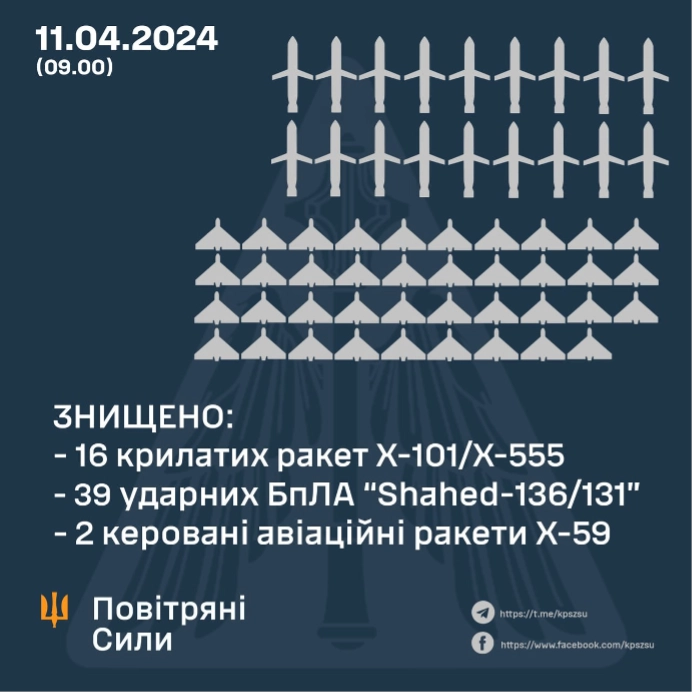
Air defense officials did not make public how those attacking weapons were shot down. In past battles the Ukrainian military has used a mix of Soviet-era and imported NATO-standard short- and medium-range anti-aircraft missiles to deal with the cruise missiles.
Anti-aircraft cannon like the widely respected German Gephard system, or mobile teams lucky enough to get into the path of an incoming drone and hit it with hand-held anti-aircraft missile machine guns mounted on pickup trucks, have become Ukraine’s main weapons to take on the Iranian drones.
All six of the Kinzhal “hypersonic” missiles hit targets and weren’t intercepted, official Ukrainian published data showed. The three MiG-31K attack jets dropping the weapons flew back to a base in Russia’s Nizhniy Novogorod Olblast without incident.
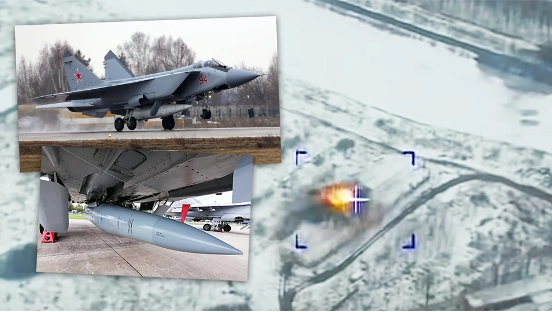
Russian mil-bloggers on Thursday morning were quick to point to at least two successful missile strikes against the Kyiv region Tripolska power plant, a coal- or oil-fired facility usually delivering about half of metropolitan and rural districts around the Ukrainian capital with power.
Social media images posted by the pro-Russia mil-blogger Readovka and rapidly re-published across Ukrainian news platforms showed a massive blaze pumping billowing black smoke into a clear blue sky. At least one missile also hit a second power plant in the Kyiv region, Ukrainian news reports said.
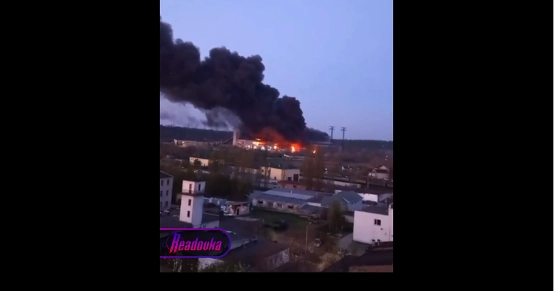
All twelve of the S-300 ballistic missiles, likewise flying at a speed well beyond the capacity of anything but modern anti-aircraft missiles to intercept, likewise weren’t touched by Ukrainian air defenses, those reports said. Ten weapons hit local power grid infrastructure causing power outages to more than 300,000 people and forcing the city’s metro to shut down. Emergency response teams were working to fix the damage, a city government statement said.
Russia’s Kinzhal missile, according to its manufactures, flies at Mach 5 hypersonic speed. Combat use seems to show its actual velocities are slower than Kremlin advertisements, but nonetheless, the weapons are difficult to intercept. The slower S-300 still flies at multiples of the speed of sound and in a ballistic arc.
The Ukrainian military’s only missile capable of knocking down a Kinzhal or hitting an incoming ballistic missile, thus far in the Russo-Ukraine War, has been the US-made Patriot.
A US halt to all arms supplies to Ukraine, effective since the end of December due to Congressional deadlock over foreign military aid and migration law reform has left Ukraine critically short of irreplaceable American Patriot missiles. The shortages were first reported in early January.
Ukrainian President Volodymyr Zelensky said of the Thursday strikes: “Russian terrorists again targeted critical infrastructure facilities. There was another vile missile attack on Kharkiv and the Kharkiv region. Objects in other regions were also targeted: Kyiv, Zaporizhzhia, Odesa and Lviv. We need air defense and other defense support, not [Western nations’] turning a blind eye and long discussions.”
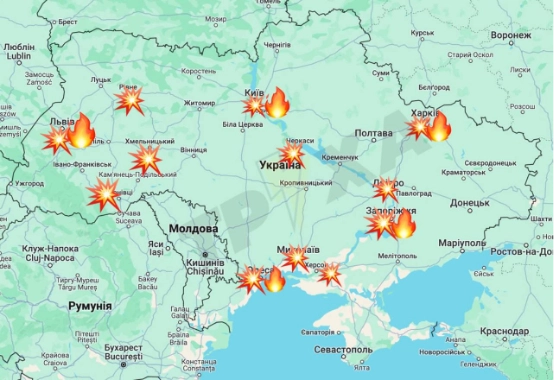
Damage to an energy facility from falling drone debris was reported in the Odesa region. Of a multi-missile strike aimed at a Zaporizhzhia power station, two missiles were destroyed but one got through.
In comments made prior to the Thursday morning air strikes, Ukrainian Prime Minister Dmytro Kuleba told the Washington Post newspaper he feels like he has been “hitting his head against a wall” trying to convince countries allied with Ukraine to transfer some of their Patriot systems to Ukraine’s military to protect Ukrainian air space.
“Nice and quiet diplomacy didn’t work,” Kuleba, Kyiv’s top diplomat, told The Washington Post in an interview this week. “We’ve tried everything, and nothing seems to work.”
During testimony in Congress on Wednesday, April 10 – about six hours before the Russian Bear bombers started launching cruise missiles at Kyiv, Lviv, Zaporizhzhia and cities elsewhere in Ukraine – Assistant Defense Secretary Dr. Celeste Wallander, and General Christopher Cavoli, commander of US Forces Europe, testified to the House Armed Services Committee that the US is doing a great deal to support Ukraine’s defenses.
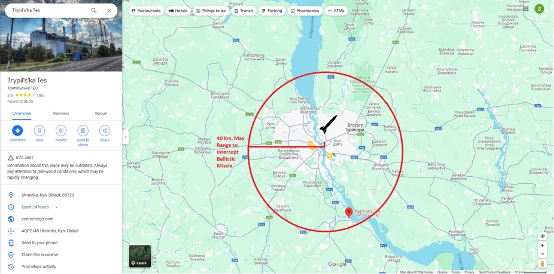
Cavolia and Wallander said more needs to be done, including to help Ukraine defend itself from Russian air attacks. Most Congress members speaking during the proceedings spoke in favor of that position.
Congressman Matthew Gaetz (R-Florida), in a minority view, questioned the wisdom of American military assistance to Ukraine because Ukraine – in his view – can never recover Donbas and Crimea, and with the reintegration of those two territories as Ukrainian war aims, US support to Ukraine would place America in a “new forever war.”
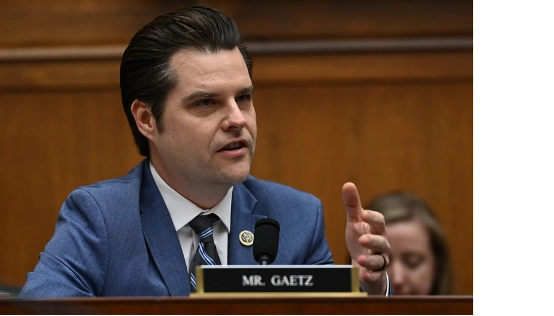
Administration officials have repeatedly stated the US has no intention of deploying combat troops to Ukraine. Cavoli in testimony said Ukrainian soldiers were wholly responsible for defending their country, but they need modern weaponry.
Gaetz told the committee that impending delivery of US-made F-16 fighter jets to Ukraine was an example of ineffective and wasteful American military assistance to Ukraine.
This was inaccurate. A coalition of states including Denmark, Netherlands, Belgium, Great Britain and Romania are financing the transfer of a planned total 42 jets to Ukraine and training of pilots and ground crew.
American participation in the overwhelmingly Europe-led and -financed initiative has been limited to partial training for a minority of the Ukrainian pilots, and a Washington green light to hand the jets over to Ukraine in the first place. Denmark and the Netherlands bought the aircraft from the US in the 1990s.
You can also highlight the text and press Ctrl + Enter


